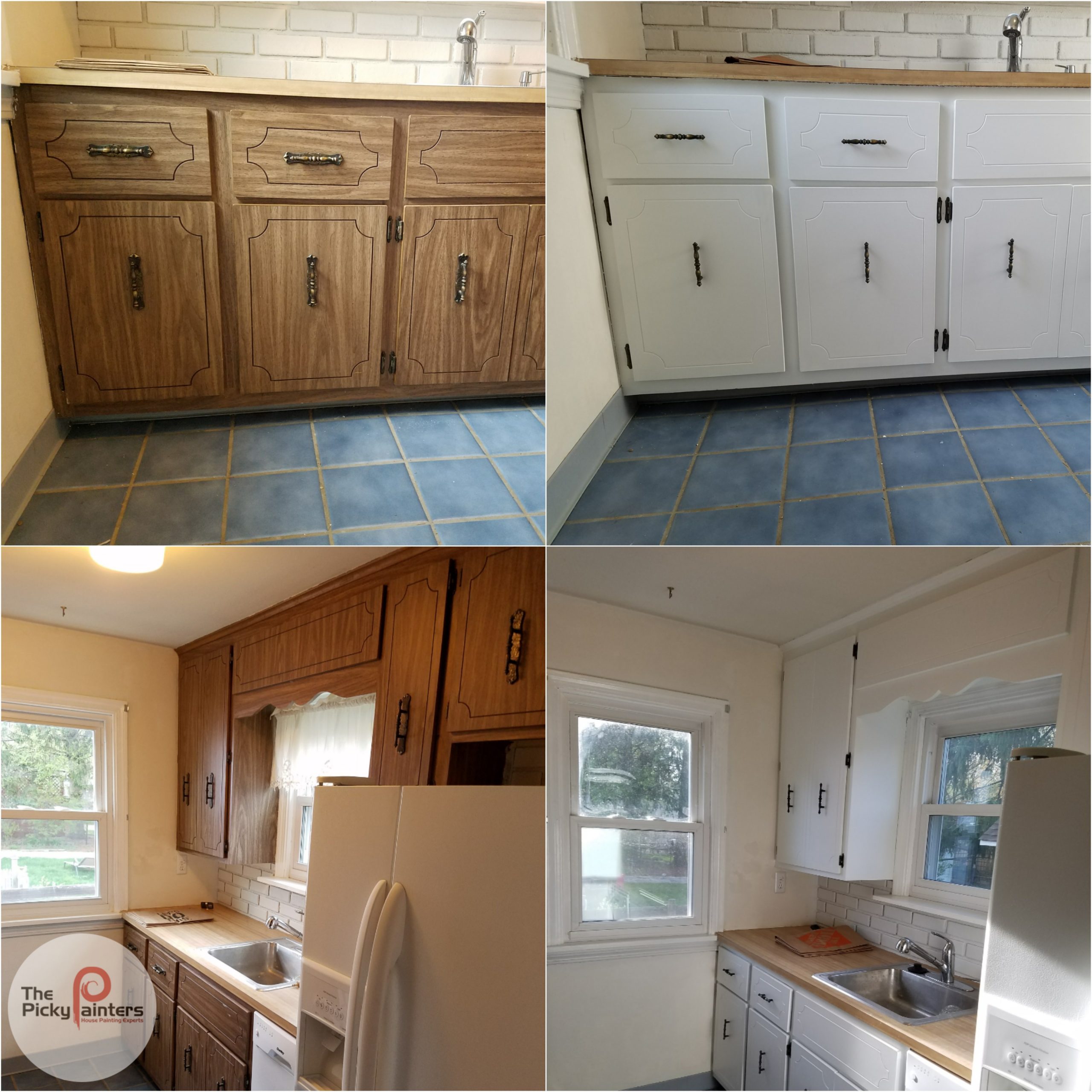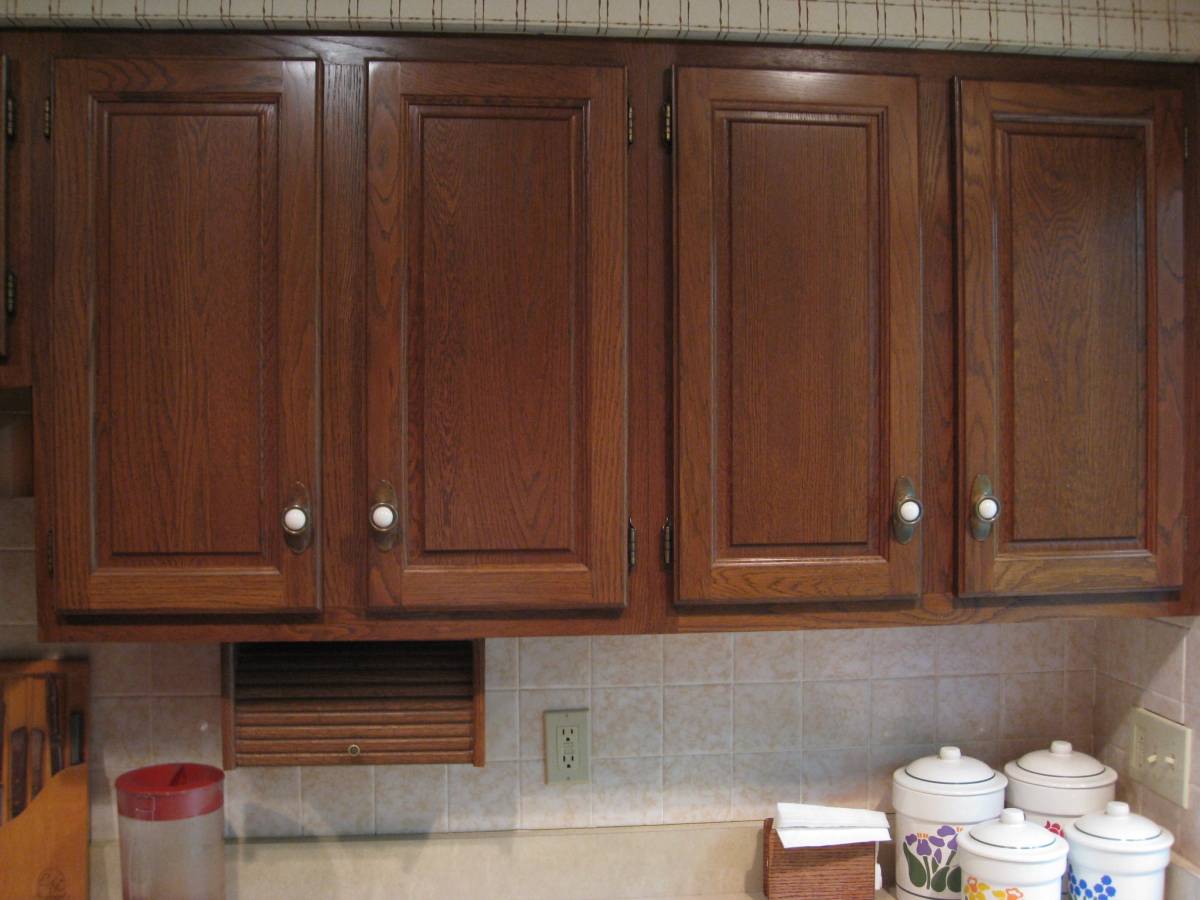Preparing Your Cabinets

A meticulous preparation process is crucial for achieving a flawless and long-lasting stained finish on your non-wood cabinets. Cleaning and sanding are essential steps that create a smooth, even surface, promoting optimal adhesion of the stain and ensuring a uniform color application.
Cleaning Non-Wood Cabinets
Thorough cleaning removes dirt, grease, and other residues that can interfere with the staining process. Different materials require specific cleaning methods.
- Laminate: Use a mild dish soap and warm water solution. Avoid abrasive cleaners or sponges that can scratch the surface. Wipe clean with a damp cloth and allow the cabinets to dry completely.
- Melamine: Similar to laminate, melamine surfaces can be cleaned with a mild dish soap and water solution. Avoid harsh chemicals or abrasive cleaners that can damage the finish. Rinse thoroughly and dry with a clean cloth.
- Vinyl: Vinyl cabinets can be cleaned with a mild all-purpose cleaner or a solution of white vinegar and water. Avoid using harsh chemicals or abrasive cleaners that can damage the vinyl. Wipe clean with a damp cloth and allow the cabinets to dry completely.
Sanding Non-Wood Cabinets
Sanding creates a rougher surface that allows the stain to adhere better and prevents it from peeling or chipping.
- Laminate: Use fine-grit sandpaper (220-grit or higher) to lightly sand the surface. Focus on areas where the stain will be applied. Sanding should be done lightly to avoid damaging the laminate.
- Melamine: Similar to laminate, melamine can be sanded with fine-grit sandpaper. Sanding should be done lightly to avoid damaging the melamine surface.
- Vinyl: Vinyl surfaces are not typically sanded. However, if you need to create a rougher surface for better adhesion, use a very fine-grit sandpaper (400-grit or higher) and sand lightly.
Using Primer for Non-Wood Surfaces
Applying a primer to non-wood surfaces is essential for enhancing stain adhesion and achieving a uniform color application. Primer acts as a bonding agent, creating a smooth, even surface that allows the stain to penetrate evenly and prevent it from being absorbed unevenly.
Primer is a crucial step in staining non-wood cabinets, as it creates a smooth, even surface that promotes optimal stain adhesion and ensures a uniform color application.
Choosing the Right Stain: How To Stain Non Wood Cabinets

Selecting the right stain for your non-wood cabinets is crucial for achieving the desired aesthetic and ensuring a long-lasting finish. Unlike wood, these surfaces often require specialized stains that adhere properly and create a durable, attractive look.
Types of Stains for Non-Wood Surfaces
The type of stain you choose will depend on the material of your cabinets. Here are some common options and their characteristics:
- Acrylic Stains: Acrylic stains are water-based, making them easy to apply and clean up. They offer good adhesion to various surfaces, including laminate, melamine, and vinyl. However, they may not penetrate as deeply as oil-based stains, resulting in a less vibrant color.
- Oil-Based Stains: Oil-based stains penetrate deeper into the surface, creating a richer, more vibrant color. They are generally more durable than acrylic stains and offer better resistance to water and scratches. However, they can be more difficult to apply and clean up, and require longer drying times.
- Gel Stains: Gel stains are thicker than traditional stains, making them ideal for vertical surfaces like cabinets. They are less likely to drip or run, ensuring even application. Gel stains offer good adhesion and can be used on a variety of surfaces, including laminate, melamine, and vinyl.
- Alcohol-Based Stains: Alcohol-based stains are fast-drying and offer a smooth, even finish. They are often used for delicate surfaces like wood veneer, but can also be applied to laminate and melamine. However, they can be more difficult to control and may require multiple coats for optimal color.
Stain Brands for Non-Wood Cabinets
Several stain brands specifically cater to non-wood surfaces:
- Rust-Oleum Cabinet Transformations: This line offers a variety of stains designed for laminate, melamine, and vinyl cabinets. They are easy to apply and provide a durable, long-lasting finish.
- General Finishes Gel Stain: General Finishes offers a range of gel stains suitable for various surfaces, including laminate and melamine. Their gel formula provides excellent adhesion and a smooth, even finish.
- Minwax Wood Finish: While primarily known for wood stains, Minwax also offers some options for non-wood surfaces. Their “Polyshades” line combines stain and polyurethane in one product, simplifying the staining process.
Selecting the Right Stain Color
When choosing a stain color, consider the existing color of your cabinets and the desired aesthetic:
- Darker Cabinets: If your cabinets are already dark, you can use a stain to deepen the color or create a dramatic contrast. Consider using a darker shade of the existing color or a contrasting color for a bolder look.
- Lighter Cabinets: If your cabinets are light, you can use a stain to add warmth and depth. Choose a light or medium shade that complements the existing color. Avoid using a dark stain on light cabinets, as it can make them appear too heavy.
- Existing Color: If you want to maintain the existing color of your cabinets, choose a stain that matches the existing shade. This will help to refresh the look without making drastic changes.
Applying the Stain

Applying the stain is the heart of the process, and it requires patience and precision. The right technique will ensure an even, beautiful finish that enhances the look of your cabinets.
Applying the Stain with a Brush
A brush is a classic and versatile tool for applying stain, especially for intricate details and tight spaces.
- Use a natural bristle brush for oil-based stains and a synthetic bristle brush for water-based stains.
- Dip the brush into the stain, removing excess by wiping it on the edge of the container.
- Apply the stain in thin, even strokes, following the grain of the material.
- Work in small sections, overlapping each stroke slightly to ensure a smooth, consistent finish.
- Avoid applying too much pressure, as this can cause streaks or uneven color.
Applying the Stain with a Roller
Rollers are ideal for covering large surfaces quickly and efficiently.
- Use a high-quality foam roller for water-based stains and a lamb’s wool roller for oil-based stains.
- Pour a small amount of stain into a roller tray.
- Roll the roller in the tray to evenly distribute the stain.
- Apply the stain in smooth, even strokes, working in small sections.
- Overlap each stroke slightly to ensure a smooth finish.
- Avoid applying too much pressure, as this can cause streaks or uneven color.
Applying the Stain with a Sprayer, How to stain non wood cabinets
Sprayers provide the fastest and most even application, especially for large surfaces.
- Use a high-quality HVLP (high-volume, low-pressure) sprayer for the best results.
- Thin the stain according to the manufacturer’s instructions.
- Practice spraying on a scrap piece of material to get a feel for the sprayer.
- Apply the stain in thin, even coats, holding the sprayer about 6-8 inches from the surface.
- Overlap each stroke slightly to ensure a smooth finish.
- Avoid applying too much pressure, as this can cause runs or drips.
Achieving a Smooth, Even Finish
To achieve a smooth, even finish, follow these tips:
- Apply the stain in thin, even coats, working in small sections.
- Wipe off excess stain immediately after application, using a clean cloth.
- Avoid applying too much pressure, as this can cause streaks or uneven color.
- Let the stain dry completely between coats, following the manufacturer’s instructions.
- Sand lightly between coats to smooth out any imperfections.
Dealing with Common Application Issues
Uneven color and bleeding are common problems when staining non-wood cabinets.
- Uneven color can be caused by applying too much pressure, not wiping off excess stain, or using an uneven application technique.
- Bleeding can occur when the stain reacts with the underlying material, causing the color to spread.
- To prevent uneven color, apply the stain in thin, even coats, wipe off excess stain immediately, and use a consistent application technique.
- To prevent bleeding, use a stain blocker or primer before applying the stain.
How to stain non wood cabinets – The art of transforming non-wood cabinets into a masterpiece of color and texture lies in choosing the right stain. But before you delve into that captivating world of hues, consider the symphony of your space. Will your cabinets harmonize with the wood flooring to go with oak cabinets you’ve envisioned?
Once that harmonious dance is choreographed, you can unleash the magic of stain, crafting a timeless beauty that speaks to your heart.
The allure of wood cabinets is undeniable, but what if your kitchen boasts a different material? Fear not, for the art of transformation knows no bounds. While wood cabinets are a staple in wood cabinet design in Pakistan , where tradition and modernity dance in perfect harmony, you can achieve a similar aesthetic with clever staining techniques.
A touch of ingenuity and the right stain can imbue your non-wood cabinets with the warmth and depth of their wooden counterparts, making them the envy of any kitchen.
